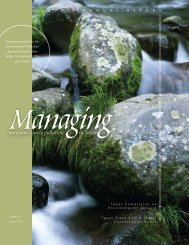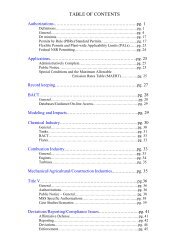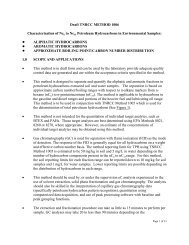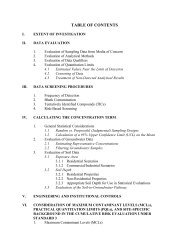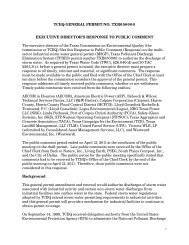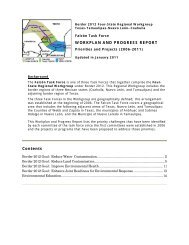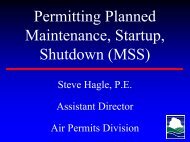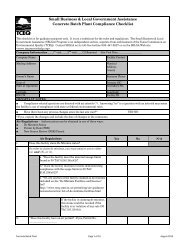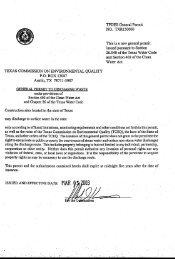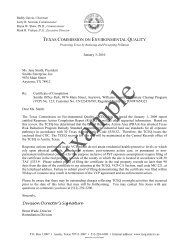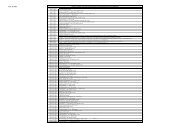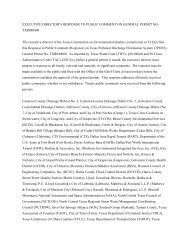TCEQ Executive Director's response to EPA ... - TCEQ e-Services
TCEQ Executive Director's response to EPA ... - TCEQ e-Services
TCEQ Executive Director's response to EPA ... - TCEQ e-Services
Create successful ePaper yourself
Turn your PDF publications into a flip-book with our unique Google optimized e-Paper software.
Bryan W. Shaw, Ph.D., Chairman<br />
Buddy Garcia, Commissioner<br />
Carlos Rubinstein, Commissioner<br />
Mark R. Vickery, P.G., <strong>Executive</strong> Direc<strong>to</strong>r<br />
TEXAS COMMISSION ON ENVIRONMENTAL QUALITY<br />
Protecting Texas by Reducing and Preventing Pollution<br />
MR CARL E EDLUND PE<br />
DIRECTOR<br />
MULTIMEDIA PLANNING AND PERMITTING DIVISION<br />
US ENVIRONMENTAL PROTECTION AGENCY REGION 6<br />
1445 ROSS A VB STE 1200<br />
DALLAS TX 75202-5766<br />
June 30, 2010<br />
Re:<br />
<strong>Executive</strong> <strong>Direc<strong>to</strong>r's</strong> Response <strong>to</strong> <strong>EPA</strong> Objection<br />
Renewal<br />
Permit Number: 02506<br />
DCP Midstream, LP<br />
Port Arthur Gas Plant<br />
Port Arthur, Jefferson County<br />
Regulated Entity Number: RN101062032<br />
Cus<strong>to</strong>mer Reference Number: CN601229917<br />
Dear Mr. Edlund:<br />
On November 13, 2009, the U.S. Environmental Protection Agency (<strong>EPA</strong>) Region 6 office<br />
signed a letter identifying objections <strong>to</strong> the issuance of the proposed federal operating permit for<br />
the above referenced site. In accordance with Title 30 Texas Administrative Code § 122.350<br />
(30 TAC § 122.350), the Texas Commission on Environmental Quality (<strong>TCEQ</strong>) may not issue<br />
the permit until the objections are resolved. In addition, the letter identifies certain additional<br />
concerns. The <strong>TCEQ</strong> understands that the additional concerns are provided for information only,<br />
and do not need <strong>to</strong> be resolved in order <strong>to</strong> issue the permit.<br />
The <strong>TCEQ</strong> has completed the technical review of your objections and offers the enclosed<br />
<strong>response</strong>s <strong>to</strong> facilitate resolution of the objections. In addition, the attached <strong>response</strong>s <strong>to</strong> the<br />
objections describe the changes, if applicable, that have been made <strong>to</strong> the revised proposed<br />
permit and supporting statement of basis (SOB). The revised proposed permit and SOB are<br />
attached for your review.<br />
P.O. Box 13087 • Austin, Texas 78711-3087 • 512-239-1000 • www.tceq.state.tx.us<br />
How is our cus<strong>to</strong>mer service? www.tceq.state.tx.us/go<strong>to</strong>/cus<strong>to</strong>mersurvey<br />
printed on recycled paper<br />
----- -------~------------.--<br />
------------
---~---~~----~----------~-~--------------------<br />
Mr. Carl E. Edlund, P .E.<br />
Page 2<br />
June 30, 2010<br />
Consistent with 30 TAC §122.350, please provide an indication of your acceptance or<br />
assessment of the <strong>response</strong>s and resolutions <strong>to</strong> the objections as soon as possible. After receipt<br />
of your acceptance <strong>to</strong> the <strong>response</strong>s and resolutions <strong>to</strong> the objections, <strong>TCEQ</strong> will issue the<br />
proposed permit. Thank you for your cooperation in this matter. Please contact<br />
Ms. Cynthia Scoggins at (512) 239-3776 ifyou have any questions concerning this matter.<br />
Sincerely,<br />
Steve Hagle, P .E., Direc<strong>to</strong>r<br />
Air Permits Division<br />
Office ofPermitling and Registration<br />
Texas Commission on Environmental Quality<br />
SHlCSIkw<br />
cc:<br />
Mr. Richard S. Rehm, Vice President, Operations, Southern Division, DCP Midstream, LP,<br />
Hous<strong>to</strong>n<br />
Ms. Lynn Ward, Senior Environmental Specialist, DCP Midstream, LP, Denver, CO<br />
Air Section Manager, Region 1 °-Beaumont<br />
Enclosures: <strong>TCEQ</strong> <strong>Executive</strong> <strong>Direc<strong>to</strong>r's</strong> Response <strong>to</strong> <strong>EPA</strong> Objection<br />
Proposed Permit<br />
Statement ofBasis<br />
Project Number: 12811
EXECUTIVE DIRECTOR'S RESPONSE TO <strong>EPA</strong> OBJECTION<br />
Permit Number 02506<br />
The Texas Commission on Environmental Quality (<strong>TCEQ</strong>) <strong>Executive</strong> Direc<strong>to</strong>r provides this<br />
Response <strong>to</strong> <strong>EPA</strong>'s Objection <strong>to</strong> the renewal of the Federal Operating Permit (FOP) for<br />
DCP Midstream, LP, Port Arthur Gas Plant, Permit No. 02506, Jefferson County, Texas.<br />
BACKGROUND<br />
Procedural Background<br />
The Texas Operating Permit Program requires that owners and opera<strong>to</strong>rs of sites subject <strong>to</strong><br />
30 Tex. Admin. Code (TAC) Chapter 122 obtain a Federal Operating Permit (FOP) that contains<br />
all applicable requirements <strong>to</strong> facilitate compliance and improve enforcement. The FOP does not<br />
authorize construction or modifications <strong>to</strong> facilities, and it does not authorize emission increases.<br />
To construct or modify a facility, the responsible party must have the appropriate new source<br />
review authorization. If the site is subject <strong>to</strong> 30 TAC Chapter 122, the owner or opera<strong>to</strong>r must<br />
submit a timely FOP application for the site and ultimately must obtain the FOP <strong>to</strong> operate.<br />
DCP Midstream, LP applied <strong>to</strong> the <strong>TCEQ</strong> for a renewal ofthe FOP for the Port Arthirr Gas Plant<br />
located in Port Arthur, Jefferson County on November 21, 2008, and notice was published on<br />
September 18, 2009 in Beaumont Enterprise. The public comment period ended oli<br />
Oc<strong>to</strong>ber 18,2009. <strong>TCEQ</strong> received an objection <strong>to</strong> the permit from <strong>EPA</strong> on November 13, 2009.<br />
In accordance with state and federal rules, the permit renewal may not be issued until <strong>TCEQ</strong><br />
resolves <strong>EPA</strong>'s objections.<br />
1~. , . . !<br />
Description of Site<br />
DCP Midstream, LP, owns and operates the Port Arthur Gas Plant, located at 1051 Highway 365<br />
in Port Arthur, Jefferson County, Texas 77640. The site is a gas treatment and compressor<br />
facility. The Port Arthur Gas Plant, Title V Permit No. 02506 contains requirements for s<strong>to</strong>rage<br />
tanks, boilers, engines and sulfur recovery operations. ..<br />
The following <strong>response</strong>s follow the references used in <strong>EPA</strong>'s objection letter.<br />
<strong>EPA</strong> OBJECTION: Pursuant <strong>to</strong> 40 CFR § 70.8(c)(1), <strong>EPA</strong> objects <strong>to</strong> the issuance of the<br />
Title V permit since the recordkeeping requirements of NSR Permit No. 46332 are not in<br />
compliance with the requirements of 40 CFR § 70.6(a)(3)(ii)(B). Under.the General Terms and<br />
Conditions provision of the draft Title V permit, refe:rence is made <strong>to</strong> 30 TAC § 122.144 of the<br />
Texas FOP program which requires records be kept for 5 years; however, 30 TAC<br />
§ 106.620(e)(8) of Standard Permit for Oil and Gas Production Facilities Permit No. 46332<br />
(revised November 13, 2008) only requires records be kept for two years. <strong>EPA</strong> states this<br />
condition is inconsistent with the 5 year recordkeeping requirements of 40 CFR<br />
§ 70.6(a)(3)(ii)(B) and cannot be carried forward in<strong>to</strong> the Title V permit. In <strong>response</strong> <strong>to</strong> this<br />
objection, <strong>TCEQ</strong> must revise the Title V permit <strong>to</strong> include a condition that states that records of<br />
moni<strong>to</strong>ring data and supporting information must be maintained for a minimum of five years
-~--~- ~~~--~~~~<br />
EXECUTIVE DIRECTOR'S RESPONSE TO <strong>EPA</strong> OBJECTION<br />
Permit Number 02506<br />
Page 2<br />
from the date of moni<strong>to</strong>ring, not withstanding the requirements of any other permit condition or<br />
applicable requirements.<br />
<strong>TCEQ</strong> RESPONSE: The <strong>TCEQ</strong> requires five year recordkeeping for all FOPs. Pursuant <strong>to</strong><br />
30 TAC §122.144(1), all records of required moni<strong>to</strong>ring data and other permit support<br />
information must be kept for a period of five years from the date of the moni<strong>to</strong>ring report,<br />
sample, or application unless a longer data retention period is specified in an applicable<br />
requirement. This is consistent with the recordkeeping requirements of 40 CFR<br />
§ 70.6(a)(3)(ii)(B). The requirements of30 TAC § 122.144(1) have been and will continue <strong>to</strong> be<br />
incorporated for all FOPs through the general terms and conditions of the FOP, which<br />
specifically require "The permit holder shall comply with all terms and conditions contained in<br />
30 TAC § 122.143 (General Terms and Conditions), 30 TAC § 122.144 (Recordkeeping Terms<br />
and Conditions), and 30 TAC § 122.146(Compliance Certification Terms and Conditions)."<br />
These requirements were (and still are) also reiterated on the cover page of the FOP.<br />
As all terms and conditions ofpreconstruct ion authorizations issued under 30 TAC Chapter 106,<br />
Permits by Rule (PBR) and 30 TAC Chapter 116, New Source Review (NSR) are applicable<br />
requirements and enforceable under the FOP, the five year record retention requirement of<br />
30 TAC § 122.144(1) supersedes any less stringent data retention schedule that may be specified<br />
in a particular PBR or NSR permit. To further clarify the five year recordkeeping retention<br />
schedule for the FOP, the following text will be added <strong>to</strong>. the General Terms and Conditions of<br />
the FOP.<br />
"In accordance with 30 TAC § 122.144(1), records of required moni<strong>to</strong>ring data and support<br />
information required by this permit, or any applicable requirement codified in this permit, are<br />
required <strong>to</strong> be maintained for a period of five years from the date of the moni<strong>to</strong>ring report,<br />
sample, or application unless a longer data retention period is specified in an applicable<br />
requirement. The five year record retention period supersedes any . less stringent retention<br />
requirement that may be specified in a condition of a permit identified in the New Source<br />
Review Authorization attachment."<br />
<strong>EPA</strong> OBJECTION: <strong>EPA</strong> objected <strong>to</strong> the Special Terms and Conditions provisions of the draft<br />
Title V permit, Condition 3 requiring stationary vents with certain flow rates <strong>to</strong> comply with<br />
identified provisions of 30 TAC Chapter 111 of Texas SIP. However, there is no identification<br />
of the specific stationary vents that are subject <strong>to</strong> those requirements. As such, this condition<br />
fails <strong>to</strong> meet the requirement of 40 CFR § 70.6(a)(1), in that the condition lacks the specificity <strong>to</strong><br />
ensure the compliance with the applicable requirements associated with those unidentified<br />
emission units. In addition, the Statement of Basis document for the draft Title V permit does<br />
not provide the legal and factual basis for Condition 3, as required by 40 CFR § 70.7(a)(5).<br />
Pursuant <strong>to</strong> 40 CFR § 70.8(c)(1), <strong>EPA</strong> objects <strong>to</strong> the issuance of the Title V permit since<br />
Condition 3 is not in compliance with the requirements of 40 CFR § 70.8(c)(I) and 70.7(a)(5).
EXECUTIVE DIRECTOR'S RESPONSE TO <strong>EPA</strong> OBJECTION <br />
Permit Number 02506 <br />
Page 3 <br />
In <strong>response</strong> <strong>to</strong> this objection, <strong>TCEQ</strong> must revise Condition 3 of the draft Title V permit <strong>to</strong> list the<br />
specific stationary vents that are subject <strong>to</strong> the specified requirements of 30 TAC Chapter 111<br />
and provide an explanation in the Statement of Basis for the legal and factual basis for<br />
Condition 3.<br />
<strong>TCEQ</strong> RESPONSE: The <strong>EPA</strong> has supported the practice of not listing emission units in the<br />
permit that only have site-wide or "generic" requirements. See White Paper for Streamlined<br />
Development ofPart 70 Permit Applications, July 10, 1995. The ED documented in the draft<br />
FOP that the Chapter 111 visible emission requirements for stationary vents were site-wide<br />
requirements - applying uniformly <strong>to</strong> the units or activities at the site. Because the applicant<br />
indicated in its application that only the Chapter 111 site-wide requirements apply <strong>to</strong> these<br />
stationary vents and other sources, the applicant is not required <strong>to</strong> list these smaller units<br />
individually in the unit summary, and therefore, these emission units did not appear in the<br />
applicable requirements summary table in the draft FOP.<br />
':<br />
With regard <strong>to</strong> stationary vents, there are three basic opacity requirements in 30 TAC § 111.111<br />
that may apply, depending upon specific applicability criteria. Stationary vents constructed on or<br />
before January 31, 1972 must meet the requirements of30 TAC § 111.111(a)(1)(A), which states<br />
that opacity shall not exceed 30% averaged over a six-minute period. Stationary vents<br />
constructed after January 31, 1972 must meet the requirements of 30 TAC § 111.111(a)(1)(B),<br />
which states that opacity shall not exceed 20% averaged over a six-minute period. Lastly,<br />
stationary vents where a <strong>to</strong>tal flow rate is greater than or equal <strong>to</strong> 100,000 actual cubic feet per<br />
minute (acfin) may not exceed 15% opacity averaged over a six minute period, unless that source<br />
has an installed optical instrument capable of measuring opacity that meets specified<br />
requirements, specified in 30 TAC § 111.111(a)(1)(C). Subsection 111.111(b) merely states that·<br />
any of the emission units subject <strong>to</strong> section 111.111 (for this permit area, this would include all<br />
stationary vents and gas flares) shall not include contributions from uncombined water in<br />
determining compliance with this section.<br />
However, the ED does agree that the FOP could be revised <strong>to</strong> more clearly group stationary<br />
vents according <strong>to</strong> which opacity limit applies. The site does not have any vents constructed<br />
prior <strong>to</strong> January 31, 1972, therefore, no vents are subject <strong>to</strong> the 30% opacity requirement of<br />
30 TAC § 111.111(a)(1)(A). All other vents .at the site are subject <strong>to</strong> 20% opacity, as noted in<br />
the revised Special Condition 3, which is a site-wide term and condition, as allowed in the White<br />
Paper for Streamlined Development ofPart 70 Permit Applications, July 10, 1995.<br />
A determination of the legal and factual basis for Condition 3 was added <strong>to</strong> the Statement of<br />
Basis document for the draft Title V permit and is enclosed.<br />
ADDITIONAL CONCERNS: <strong>TCEQ</strong> acknowledges the additional concerns <strong>EPA</strong> has with the<br />
Port Arthur Gas Plant FOP and will address these issues as appropriate .<br />
. _------_._---



